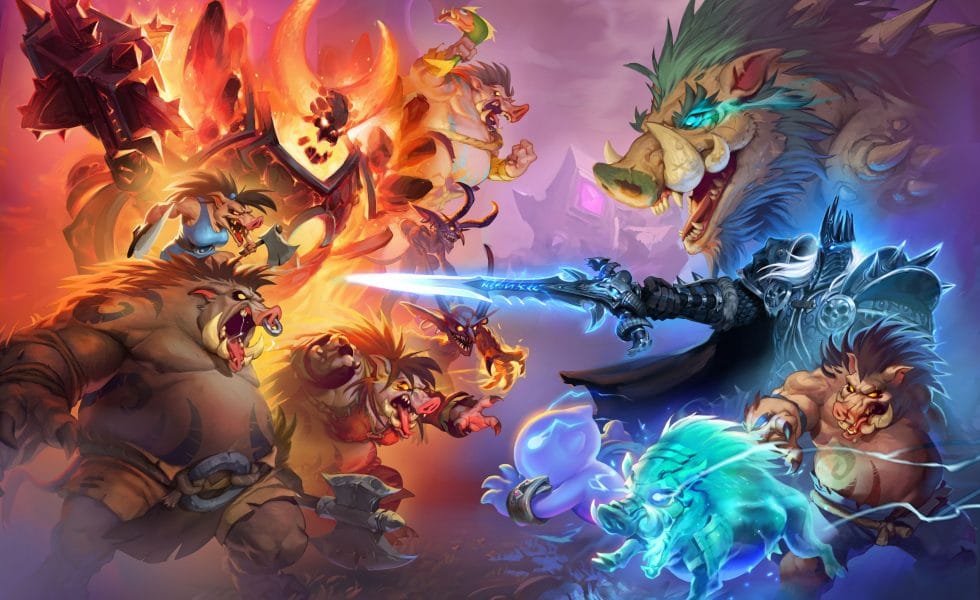Working on a video game is an achievement that seems unattainable for most of us. We love to play, of course, but there’s a lot of mystery veiling the how-to of the industry that produces our favourite titles. In the spirit of demystifying the process, we had the pleasure of speaking to Alec Dawson (Lead Designer, Final Design) and John McIntyre (Game Designer), the team behind the magic of Hearthstone. For those at the back, Hearthstone has been heralded as one of, if not the, best digital card game in the world, building upon the existing lore of World of Warcraft. With its new Battlegrounds update, there’s no card collection requirement to get started, making the game more than accessible enough for new users to play. With those considerations in mind, we spoke to the duo about the future of Hearthstone, what a day in the life of a game designer looks like and their journey to getting there.
This new update to Hearthstone is meant to make the game more accessible. What brought that on?
Alec: I think with the new year, one of the things we wanted to do is to make sure that, “Hey, if you haven’t played Hearthstone in a while, you can jump back in and make that an easier process.” We’ve been working on that for quite a while. I think some of this stuff that came in a few months ago with 20.0 and some of the more recent stuff we’re now making, you can just get in, you can get a deck. You can actually get a full deck now. So there’s a ton of different things we’re doing because we hear that feedback from players who come to us like, “Hey, I want to, how do I do it?”, and making that a much more clear road and a path for them to come in and start having fun with Hearthstone immediately.
John: I think if you look at the game two years ago, one of the complaints was that we just weren’t doing enough content. And so one thing that we’ve been working with is adding more content without necessarily increasing the price of the game. With ‘Forged in the Barrens’, our most recent big update, we added a core set of cards where you just get into the game and you get these cards for free and they’re just good cards. Then, of course, with this update, we have sellable decks where these are supposed to be competitive decks that for a flat rate, you can buy and start playing with at a competitive level.
Is there anything that you plan to do or that you’ve done with the intention of increasing the sense of community and the relationships that people can build in the game?
Alec: Yeah, we’re actually thinking about even expanding some of those options right now. I think one big thing for Hearthstone down the road is going to be more customisation and giving you more choices when you come into the game. Where maybe, down the road, we can do different emotes and you can start playing around with those and things that you want to say to the opponent. I think also backing up, a bit more on the wider community, we’ve been trying to do some things lately, where we now have a day on the 15th of every month that’s Nozdormu day. We’ve tried to encourage everyone to put Nozdormu into their deck of cards, where if both players have him in their deck, the game’s faster. We’re just trying to find more fun ways to make Hearthstone feel like that social experience. You come into the Tavern and it feels like you’re actually in that place.
John: It’s been about a year now, but adding lobbies to Battlegrounds was a huge change. I can jump on the Discord with a group of my friends and be like, “Hey, let’s play a game”, and four of us just hop into the ladder together. That’s a great way of being able to play the game with my friends. More than just a one-on-one situation.
I love that. In terms of the field of game design, how did you get on this career path?
John: I guess growing up in school, I did a lot of little game projects playing around on some of the free game engines. I went to university for it, but there are a lot of very talented people that I work with that didn’t go to university for it. There are other paths to it.
Alec: I also went the university route there too. I think one of the things that John mentioned, at the same time I was learning these different tools…There’s a lot of stuff out there now. You can go and if you want to make a game, you can. If you have your idea, you can go in and you can actually try stuff out on a lot of the software nowadays. That was pretty cool, being in university and being able to experience that as well.
What does a day in game design look like?
John: For me, I work on cards. In the morning, I wake up and I start designing some cards and I have to implement them. Around 10:30, we do a team playtest and we’ll playtest all the way till about lunchtime. During that playtest, we talk about what we want to change and improve about what we’re working on. The rest of the day, it’s usually meetings, talking to all the other different disciplines. There’s just a lot of communication involved and making sure everyone’s on the same page. The next day it starts over, where I start designing based on the feedback I got from the previous playtest.
Alec: I think, it’s really rewarding in the sense of, what you put in it, it’s actually going to go into the hands of the players and you get to see their reactions. Right? I think that there’s something really special about that, but the process itself sometimes can be pretty tough. Like cracking the code the first time. You can also have a bunch of interesting cards by themselves and then the combinations between don’t add up and it’s not really that mechanism that you’re looking for…There’s a lot of trial and error involved. I think in particular [as] game designers, you need to be able to have that sense of, “Okay, we’re going to have to try it again.” We’re going to keep it or we’re going to keep going at it until you find a product that actually starts working.
What do you think is the direction that the gaming industry is moving towards to get to the next big thing?
John: One thing that we’re seeing from games…There are maybe fewer games and a lot more effort put into developing them. I think Hearthstone’s a great example, where we’ve got normal Hearthstone, but then we kept developing on it. That’s how we’re able to create game modes like Battlegrounds, Duels and Mercenaries, which is coming out at some point this year. I think in the past, maybe you’ve just hopped from one game to the next and now you really just try and expand upon your game to make it as good as possible, I guess.
Alec: I think a lot of it is the tools available are being taught to a younger generation, as we keep going. It’s easier and easier to go in and make games. Whether you’re in something with like user-generated content, there are tools within game environments themselves that you can now log into and start making something…I think that’s amazing, looking back at the games I was playing when I grew up. Also how the media has crossed into games in terms of the mainstream. It has actually happened, you can see concerts in videogames now. You see a bunch of stuff like that. So it’ll be interesting to see what happens next in terms of those places.
Are you still big gaming fans? Are there other games that you’re really into, or is it Hearthstone for life?
John: I play a lot of games. A lot of it is Hearthstone and the various games that are there, but I also am a big fan of shooters. Heroes of the Storm, I’m playing a lot with my friends. What about you, Alec?
Alec: Honestly, part of game design is studying what’s coming out too. Making sure you’re caught up on all the latest trends. I think one thing for me is, I love the haptic feedback in the PS5 controller. I’ve been trying to play a bunch of games on that. I got pretty lucky to snag one. We’re playing games all the time. It’s important for us to get better at our jobs, and I think experiencing and seeing what other designers are doing is so invigorating.







